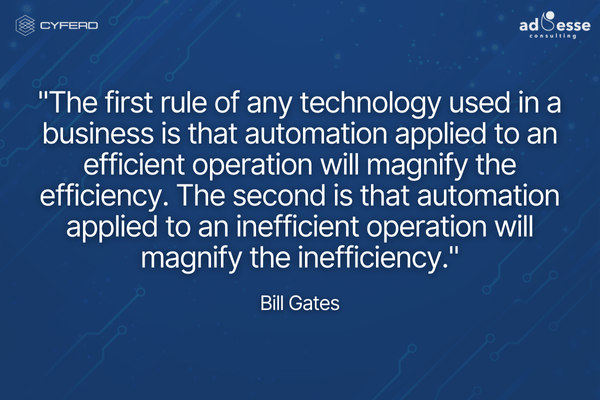Guest Post
Ensuring a Successful Systems Implementation

Rhiannon Gibbs
Director at Ad Esse Consulting
Systems and technology are truly wonderous; there are almost unlimited possibilities and opportunities for making our lives better. However, most organisations pursuing new technology can’t describe a successful outcome for their last system implementation (new CRM system anyone?), which begs the following questions – what is going wrong? And why would things be different this time?
Many organisations implement new systems with the aims of becoming more efficient, and to reduce the errors in their work. Unfortunately, their starting position is with poor, error-prone, undocumented, and non-standardised processes and data. It is assumed that implementing a system will fix this. It won’t! And in the bottom of your heart, you know it won’t!
If you start designing a system around poor, non-standardised ways of working, or simply design your system around how things ‘should work’ (but the reality is that they have never worked that way), your system implementation will fail.
Bill Gates summed this up best when he said:

You must have robust, value-adding processes and working practices in place BEFORE you introduce any technological enhancement to drive further efficiencies. If you’re wondering why your transformations (of any kind) aren’t delivering results, take our free Transformation Health-Check [here].
Whilst most organisations know how to implement an IT system, they don’t know how to design good processes and change the way people do things day-to-day. So, what happens is decision makers put their heads in the sand and pretend that millions spent (wasted) on IT systems are justified because they perceive that not having the systems puts them ‘behind the curve’.
You’ve probably heard the phrase, ‘no one gets fired for hiring McKinsey.’ Well, it seems no-one gets fired for rolling out MS Dynamics.
It’s time to call out and change these practices. If you are implementing an IT system and you haven’t already got good working processes and practices in place, you are wasting money. If you are in the public, charity or not-for profit sectors then it’s not money from shareholders’ pockets you’re wasting, it’s money from taxpayers, tenants, donors, or members of the public.
The digital angle plays an important part of any transformation, but it’s an enabler of better services, not the objective of your transformation. Read that sentence again and let it really sink in. Anyone who has a digital transformation underway now needs to take a step back and ask themselves “what is the driver for the ‘digital’ transformation” and then consider re-naming their efforts. Please let us never see ‘implement AI’ as a blanket statement in a strategy document again!
‘Technology first’ is dead! The new world, where we can better utilise the capabilities that technology can offer, is to accept the tech for what it is, an enabler, and to take a purpose centric ‘service design’ view first.
Learn more about Ad Esse Consulting [here] or fill in the form below to get started.
Find out more About Cyferd
New York
Americas Tower
1177 6th Avenue
5th Floor
New York
NY 10036
London
2nd Floor,
Berkeley Square House,
Berkeley Square,
London W1J 6BD
